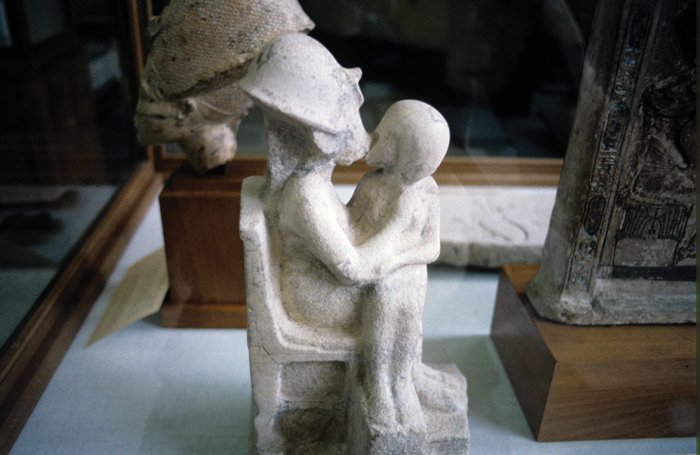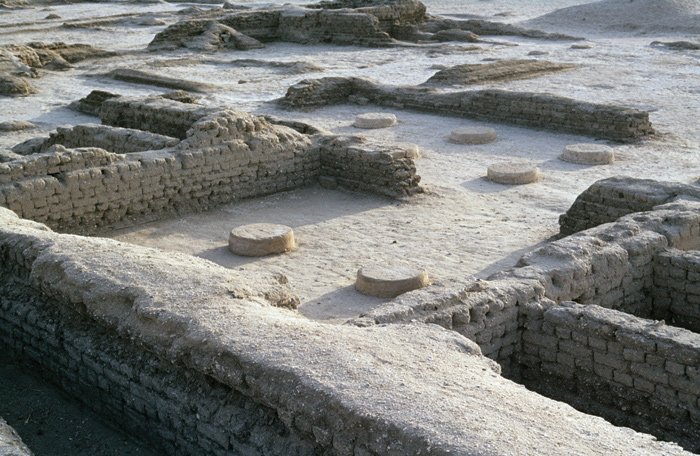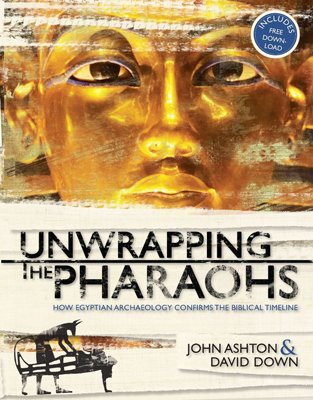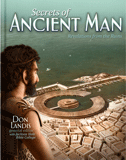
Chapter 21
Akhenaten and Nefertiti the Beautiful
The Ascension of Amenhotop IV to the throne marked the beginning of the most intriguing and controversial era of Egyptian history.
Amenhotep IV had been crowned as co-regent king at least eight years before his father’s death, but at the beginning of his reign he quickly set about implementing his radical religious views. His grandfather, Thutmosis IV, had already hinted at a new emphasis on the worship of the sun disc Aten, and his father had fostered this by cultivating the cult of the sun. Akhenaten came right out into the open and declared his fidelity to Aten in preference to all other Egyptian deities, though he did not immediately condemn the worship of Amun.
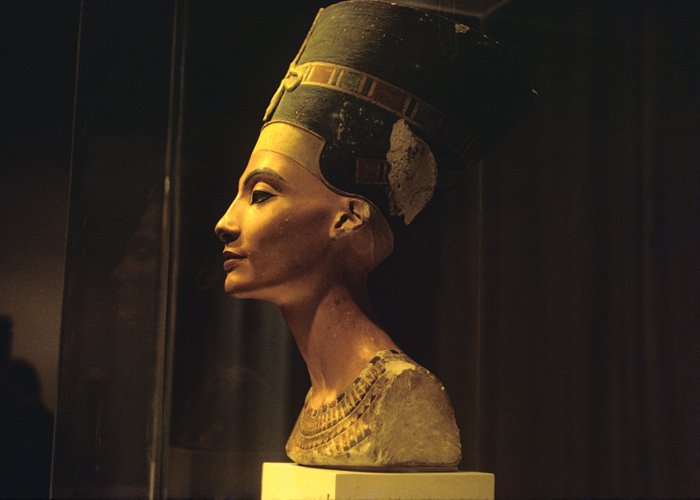
This bust of Nefertiti was smuggled out of Egypt by German archaeologists who were excavating at Tel el Amarna and is now in the Berlin Museum. Nefertiti means “The beautiful one has come.”
However, he soon showed his hostility for Amun. Even before his father’s death, probably in the fourth year of his co-regency, he changed his name from Amenhotep, meaning “Amun is satisfied,” to Akhenaten, probably meaning “of service to Aten.” To get right away from the influences of the priests of Amun at Luxor, he decided to build a new capital city. Halfway between Luxor and Memphis, he selected a plain, with the Nile on one side and a semi-circle of hills on the east side, and called it Akhetaten, meaning “horizon of the Aten.” He moved his whole court there two years later.
It was a magnificent, well-laid out city with a palace and temple, public gardens, a sacred lake, and neat private houses. The site is now known as Tel el Amarna. The new city was built quickly and was dedicated in year six. By year nine, the city was fully functional.
His father must have approved the move, no doubt encouraged by his name being deified, and the persecution of the god Amun was launched. Temples were destroyed, inscriptions were altered or defaced, and statues smashed. The name “Amen” was even chiseled out of his father’s name inscribed on a capital of Amenhotep’s temple at Luxor.

Akhenaten’s statue depicts him as having pinched cheeks, a distended belly, and thick legs. This was probably an art style rather than a physical abnormality.
Akhenaten’s statues depict him as rather grotesque with an elongated head, thick lips, pinched cheeks, protruding abdomen, and thick thighs. Is that what he really looked like or was this a new art form? Advocates of the former theory endeavor to identify his deformity as Marfan’s syndrome, an inherited disorder caused by a defective gene. However, their arguments are not convincing, and they do not explain why his family and even courtiers are depicted with similar features.
Others have suggested that he was a victim of Frolich’s syndrome, but this abnormality results in impotence, and Akhenaten fathered six daughters. It is not realistic to explain this away by saying that some other male fathered his wife Nefertiti’s children. Nefertiti might have gotten away with it once, but not six times
In favor of the art form theory is the fact that he himself was into art. His chief sculptor, Bek, wrote that Akhenaten taught him style and technique. There is no doubt that Akhenaten was a brilliant scholar and had an innovative mind. He was one of the few pharaohs who could write the complicated hieroglyphic script, and he wrote some beautiful hymns to Aten.
One interesting feature of Amarna art is the depiction of people with a right and left hand. Before and after that, it was customary to depict people with two left hands. The Amarna artists only mastered the distinction between left and right hands and feet some time between years six and nine of Akhenaten's reign, and even then it was only applied to royalty. Other citizens had to manage with two left hands and two left feet.
Akhenaten possessed many good qualities. No doubt, he had the wrong religion, but it was a vast improvement on the existing religion with its ridiculous worship of anything that walked, flew, or crawled. He was a man of convictions who was ready to defy tradition to pursue his religious beliefs. He appears as a kindly family man who loved his wife and children.
Theirs was apparently a devoted marriage. The fact that Nefertiti bore him six daughters and no sons did not seem to diminish his affection for her. So many reliefs show them as a close and affectionate family. The king wrote, “My heart is pleased with the queen and her children. May old age be granted to the Great Queen Neferneferuaten-Nefertiti. . . . And may old age be granted to her children.”1
It was not to be. By year 12 of their reign only three of their daughters are depicted in reliefs, implying that three had tragically met an early death.
Akhenaten is often shown as a loving family man, dandling daughters on his knees. There is one statue in the Cairo Museum with his daughter Meritaton on his knees, and he is affectionately kissing her on the lips. Of course this can be construed as more than fatherly love, because he finished up by marrying two of his daughters, Meritaton and Ankhesenpaten. He also had other wives in his harem.
Year 12 is the last time the royal family is depicted being together. Does this mean a break-up in family relationships, a new art style, or the death of Nefertiti? All that can be said is that this was a year of lavish celebrations. Ambassadors and governors of foreign countries were summoned to appear, but the purpose of the ceremonies remains a mystery.
He has been called by some as the first monotheist of history. That claim can no longer be supported, because the revised chronology would place him at a later time than Moses. If anyone copied anyone, it was Akhenaten who emulated the teachings of Moses, but there is no evidence to prove that any copying was involved, and recent scholarship has shown that he was not really a monotheist. He certainly was hostile to Amun and relentlessly opposed his worship, but he still condoned the worship of Osiris.
Rolf Krauss, writing in The Bulletin of the Australian Centre for Egyptology, admits that Akhenaten was devoted to the sun disc Aten, and that he had it in for the sun god Amun, but insists that he was not a monotheist. Krauss takes scholars to task for not pointing out that while Akhenaten was obviously out to destroy the god Amun, there were other gods who were not the object of his wrath. He claims that they well knew this, but in order to promote the idea of monotheism, they deliberately chose to ignore evidence to the contrary.2
One scene originally showed Akhenaten’s father, Amun, and the goddess Hathor. Her image, like those of most other gods and goddesses in Amenhotep III’s memorial temple, was not attacked during Akhenaten’s religious purge. Krauss wrote, “The conclusion seems inescapable that Akhenaten recognized Ptah-Sokar-Osiris as a god—a god for whom he may have shown no great personal interest, but whom he evidently found acceptable in the context of the funerary cult of his father.”3
Then there was the exaltation of the cobra. Most pharaohs had the cobra on the front of their crowns, ready to strike at their enemies. At Amarna, excavators found many clay figures of cobras. Krauss reasons that their “presence show that the inhabitants of Amarna worshiped these cobras and gave offerings to them.”
In his accusations Krauss seems to suggest that religious bias had something to do with what he sees as a bit of a cover-up.
“Specialists were also aware of the fact that Akhenaten tolerated other Egyptian gods. But European and North American scholars were prejudiced. They lived and thought within a monotheistic cultural and religious framework, and they seem to have been eager to recognize the basic monotheistic ideas of their own Judeo-Christian heritage in Akhenaten’s sun cult.”4

Hundreds of cuneiform tablets were found at Tel el Amarna. They were used for correspondence between the pharaoh and his subjects in Asia.
Krauss undoubtedly has a point about Akhenaten’s polytheism, but it should be observed that it was not the proponents of Christianity who made the comparisons about monotheism; it was the critics of the Bible. They gleefully pointed out that Moses did not originate the concept of monotheism. He got it from Akhenaten. They were working on the assumption that Akhenaten preceded Moses.
Some scholars parrot the idea that David, in Psalm 104, copied Akhenaten’s hymn to the Aten. In the first place, by a revised chronology, Akhenaten would have been later than King David, so if anyone copied anyone, it would be Akhenaten that copied David; but second, the similarities are grossly exaggerated, and there is one major difference. Whereas David ascribes the existence of the sun to the power of God, Akhenaten regarded the sun itself as the god. He wrote, “Glorious, you rise on the horizon of heaven, O living Aten, creator of life. . . . You created the world.”5 Contrast this with “O Lord my God, you are very great: you are clothed with honor and majesty, who cover yourself with light as with a garment, who stretched out the heavens like a curtain” (Psalm 104:1–2). It is absurd to say that David copied Akhenaten’s hymn.
Many differing tales have been told as to how the bust finished up in Berlin. There can be no doubt that it was smuggled out of Egypt, but whether by a bizarre deception, or a careless oversight by an Egyptian authority is open to question.
The German Egyptologist Ludwig Borchardt was the one who was in charge of the excavations at Tel el Amarna when the beautiful bust of Nefertiti was found. The Germans were given authority to commence excavations at Tel el Amarna in 1907, but did no serious digging until 1911. In 1912, the team came across the workshop of the sculptor Djhutymes and found a number of unfinished stone heads and busts of Amarna royals and also a large number of plaster masks. Then on December 6 came the sensational discovery of the head of Nefertiti, the most beautiful statue that has ever been found in Egypt.
The discoveries were spectacular, but the Germans were not about to give that impression to Gaston Maspero, the French head of the Egyptian Antiquities Service at that time. Borchardt wrote to Maspero and invited him to come to Amarna to sort out the finds which, he casually said, were not very remarkable. Maspero swallowed the story and sent an Egyptian deputy for the occasion. The deputy selected a few heads for the Egyptian Museum and authorized the rest of the discoveries, labeled “baskets of clay shards and many limestone fragments,” to be shipped out of the country, and Nefertiti sailed for Berlin.
Very prudently, the Germans kept Nefertiti under wraps until 1924. They hinted that the 1914–1918 war had delayed the announcement of the great discovery, but more likely it was apprehension over the reaction that they expected. Sure enough, when Nefertiti went on display, the Egyptian authorities sent up a justifiable howl of protest, demanding that Nefertiti be returned to Egypt.
Borchardt asserted that he had an agreement with Maspero, allowing the Germans to take the statue to Berlin. Fortunately for Borchardt, Maspero had died in 1916, so it was his word against the rest, but as the saying goes, possession is nine-tenths of the law; Nefertiti is still in Berlin. The Egyptians were justifiably annoyed and vented their feelings by excluding Germans from excavating in Egypt for an indefinite period. That ban has now been lifted, and Germans are working in several sites, but the Egyptians are still demanding the return of Nefertiti.

An unfinished head of Nefertiti. Joanne Fletcher claimed that the female mummy found in the tomb of Amenhotep II was the body of Queen Nefertiti. Most archaeologists have rejected this claim.
Of course, there is still speculation as to whether Nefertiti was really that beautiful—or if she just had a good sculptor. Her name means “The beautiful one has come,” and at least her husband thought she was outstandingly beautiful. On his boundary stela he wrote, “Fair of face, joyous with the double plume, mistress of happiness, endowed with favor, at hearing whose voice one rejoices, lady of grace, great of love, whose disposition cheers the lord of the two lands.”6
There is a large statue in the Cairo Museum which has provoked much speculation. There is no name on the statue, but it is generally assumed to have been of Akhenaten, and it depicts him without any clothes on—and without something else. Some have concluded from this that Akhenaten was impotent, but as we have already mentioned that would seem unlikely.
Suggestions have ranged from Akhenaten being a homosexual to the idea that someone may have knocked it off for a doorstop. Joyce Tyldesley asserts that the statue was unfinished and would have eventually been carved or painted to show the kilt. Joyce herself did not seem to be very convinced by her own argument because she finishes up by saying that it may, after all, have been a statue of Nefertiti.
Others have suggested it denotes that in later years he became the female partner in a homosexual relationship, and someone even suggested that he was a female pharaoh. None of these ideas can be supported by solid evidence.
Something dramatic seems to have happened at Akhetaten. Nefertiti suddenly disappears from the records. Does this imply her early death, as some have suggested, or that she fell into disgrace and was removed from office. In support of this idea it has been pointed out that she had a palace at the opposite end of the city to which she may have been banished, but if she fell into disfavor, is it likely that the king would build a special palace for her? Pharaohs had ways of disposing of rejected wives without building magnificent palaces for them.
In contrast to this theory is the speculation that she was not just the power behind the throne, she was the monarch on the throne. Tiye had achieved almost equality with Amenhotep III. Nefertiti almost seemed to surpass her husband in political importance. Broken blocks recovered from one of his temples that had been demolished after his death reveal an imbalance in pictorial prominence in favor of Nefertitti.

On this barren plain at Tel el Amarna once stood Akhenaten’s resplendent new city of Akhetaten. The building materials were subsequently taken for buildings elsewhere.
In the blocks so far analyzed there were 329 occurrences of the figure or name of the king, but 564 of Nefertiti’s name or image. Analysis of more blocks may redress this imbalance, but it is obvious that Nefertiti wielded an enormous amount of power and prominence compared with previous queens.
What is even more unprecedented is the depiction of Nefertiti in “a smiting role.” One relief shows her with club upraised about to bash the brains out of a female captive. Whether Nefertiti ever performed such a murderous act, or whether this was just a stereotyped pharaonic method of depicting power, is anyone’s guess. One thing seems sure: she was equal with the male ruler.
There is no inscriptional record of Nefertiti’s death, so what really happened? Did she die? Was she killed? Did she fall into disgrace? Or did she become the pharaoh on Akhenaten’s death? If the latter, Nefertiti would have become a divine being, but there is no firm evidence for that. Some have tried to recognize a compromise between divinity and humanity in the queen, but as Joyce Tyldesley says, “The idea that one could be semi-divine seems very similar to the old joke of a naïve girl claiming to be just a little bit pregnant.”7
One of the most intriguing questions about Nefertiti is her missing eye. Her left eye is there, but it has no features. Did the sculptor never get around to finishing the face? Did some enemy mutilate it? Was she really blind in that eye? Maybe the artist simply used it as an artist’s model to allow students to study techniques.
Akhenaten was not a warrior pharaoh, but he was a political diplomat. In 1887, a sensational discovery was made at Tel el Amarna. Some clay tablets with cuneiform writing were discovered. At first they were dubbed a forgery. Everyone knew that the script of Egypt was hieroglyphic, but then it was realized that this was from Akhenaten’s archives and consisted of correspondence between the Egyptian court and Egypt’s subjects and allies in foreign countries. Altogether, there were some 358 such tablets, but because they were initially regarded as frauds, most of them have been lost.
Most books claim that Akhenaten was so preoccupied with his religious reforms that these pleas for help fell on deaf ears, but they actually reveal a lively correspondence between the pharaoh and his allies. They are mostly from the time of Amenhotep III and his son Akhenaten.

When the Amarna Period ended, the temples to the Aten were demolished. Thousands of blocks of stone called talatat have been collected by archaeologists who are trying to put them together again.
Most scholars have tried to fit these letters into the conventional chronology, about 1410 to 1370 B.C., but they fit better into the revised chronology, which would place them about 870–840 B.C. There were 60 letters from the king of Sumur. It would be ridiculous to identify him as the king of the Sumerians who lived far away in southern Iraq. It is more logical to identify him as the king of Samaria, but the problem for the traditionalists is that Samaria, the capital of the ten tribes of Israel, was not founded until King Omri purchased the hill on which it was built in the ninth century B.C. (1 Kings 16:23–24).
A surface reading of the biblical record seems to present Israel as an independent nation, but it is significant that Samaria had a governor named Amon (1 Kings 22:26), and Amon is a typically Egyptian name. He is called Aman-appa in the Amarna letter number 73. Letters 74 and 85 speak of a famine in Sumur, and there was such a severe famine in the days of King Ahab (1 Kings 18:2).
Unfortunately, there is hardly anything left of Akhenaten’s beautiful city. After his death it was abandoned, and Egypt returned to the worship of the god Amun and all the tributary gods. The stones of the city were pillaged for buildings by later pharaohs, and little remains of the palaces of Akhenaten and Nefertiti for tourists to see.
Unwrapping the Pharaohs
Adults and children alike are fascinated by Egyptian civilization. But most modern archaeologists have lately tried to use Egyptian chronology to dispute the biblical record. Secular textbooks and videos challenge the faith of students and discredit the biblical account of Exodus. Those who wish to defend the accuracy of the Bible now have an incredible tool in this exciting book that provides compelling confirmation of the biblical account.
Read Online Buy BookFootnotes
- Joyce Tyldesley, Nefertiti: Egypt’s Sun Queen (London: Penguin Books, 1999), p. 55.
- Rolf Krauss, “Akhenaten: Monothesist? Polytheist?” The Bulletin of the Australian Centre for Egyptology, vol. 11 (2000): p. 93–101.
- Ibid., p. 95.
- Ibid., p. 99.
- Tyldesley, Nefertiti: Egypt’s Sun Queen, p. 86.
- Cyril Aldred, Akhenaten, Pharaoh of Egypt; A New Study (London: Abacus, 1972), p. 12.
- Tyldesley, Nefertiti: Egypt’s Sun Queen, p. 148.
Recommended Resources

Answers in Genesis is an apologetics ministry, dedicated to helping Christians defend their faith and proclaim the good news of Jesus Christ.
- Customer Service 800.778.3390
- © 2024 Answers in Genesis




